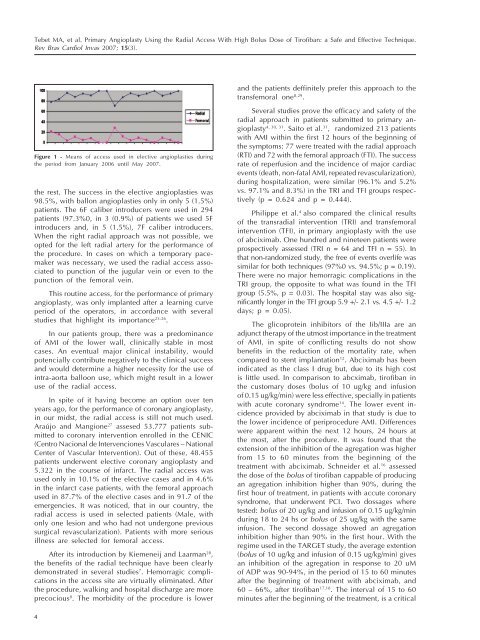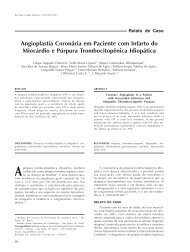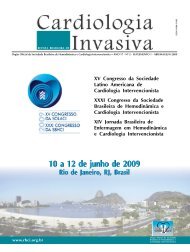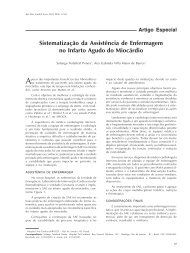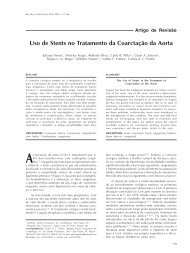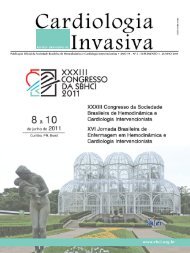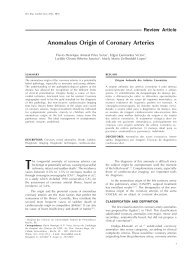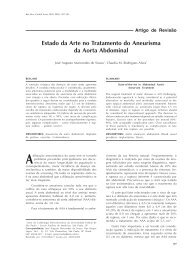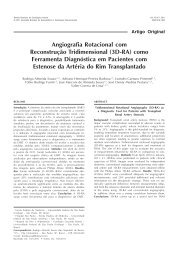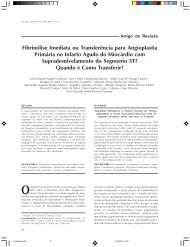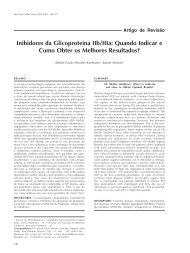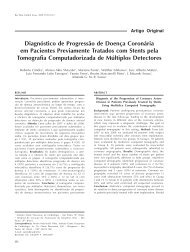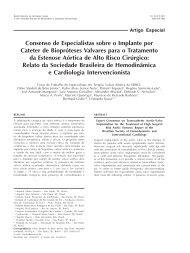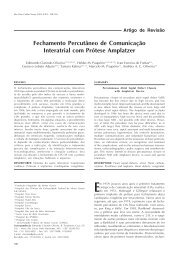Marden Tabet ING.pmd - Revista Brasileira de Cardiologia Invasiva
Marden Tabet ING.pmd - Revista Brasileira de Cardiologia Invasiva
Marden Tabet ING.pmd - Revista Brasileira de Cardiologia Invasiva
You also want an ePaper? Increase the reach of your titles
YUMPU automatically turns print PDFs into web optimized ePapers that Google loves.
Tebet MA, et al. Primary Angioplasty Using the Radial Access With High Bolus Dose of Tirofiban: a Safe and Effective Technique.<br />
Rev Bras Cardiol Invas 2007; 15(3).<br />
Figure 1 - Means of access used in elective angioplasties during<br />
the period from January 2006 until May 2007.<br />
the rest. The success in the elective angioplasties was<br />
98.5%, with ballon angioplasties only in only 5 (1.5%)<br />
patients. The 6F caliber introducers were used in 294<br />
patients (97.3%0, in 3 (0.9%) of patients we used 5F<br />
introducers and, in 5 (1.5%), 7F caliber introducers.<br />
When the right radial approach was not possible, we<br />
opted for the left radial artery for the performance of<br />
the procedure. In cases on which a temporary pacemaker<br />
was necessary, we used the radial access associated<br />
to punction of the jugular vein or even to the<br />
punction of the femoral vein.<br />
This routine access, for the performance of primary<br />
angioplasty, was only implanted after a learning curve<br />
period of the operators, in accordance with several<br />
studies that highlight its importance 23-26 .<br />
In our patients group, there was a predominance<br />
of AMI of the lower wall, clinically stable in most<br />
cases. An eventual major clinical instability, would<br />
potencially contribute negatively to the clinical success<br />
and would <strong>de</strong>termine a higher necessity for the use of<br />
intra-aorta balloon use, which might result in a lower<br />
use of the radial access.<br />
In spite of it having become an option over ten<br />
years ago, for the performance of coronary angioplasty,<br />
in our midst, the radial access is still not much used.<br />
Araújo and Mangione 27 assesed 53.777 patients submitted<br />
to coronary intervention enrolled in the CENIC<br />
(Centro Nacional <strong>de</strong> Intervenciones Vasculares – National<br />
Center of Vascular Intervention). Out of these, 48.455<br />
patients un<strong>de</strong>rwent elective coronary angioplasty and<br />
5.322 in the course of infarct. The radial access was<br />
used only in 10.1% of the elective cases and in 4.6%<br />
in the infarct case patients, with the femoral approach<br />
used in 87.7% of the elective cases and in 91.7 of the<br />
emergencies. It was noticed, that in our country, the<br />
radial access is used in selected patients (Male, with<br />
only one lesion and who had not un<strong>de</strong>rgone previous<br />
surgical revascularization). Patients with more serious<br />
illness are selected for femoral access.<br />
After its introduction by Kiemeneij and Laarman 28 ,<br />
the benefits of the radial technique have been clearly<br />
<strong>de</strong>monstrated in several studies 7 . Hemorragic complications<br />
in the access site are virtually eliminated. After<br />
the procedure, walking and hospital discharge are more<br />
precocious 8 . The morbidity of the procedure is lower<br />
4<br />
and the patients <strong>de</strong>ffinitely prefer this approach to the<br />
transfemoral one 8,29 .<br />
Several studies prove the efficacy and safety of the<br />
radial approach in patients submitted to primary angioplasty<br />
4, 30, 31 . Saito et al. 31 , randomized 213 patients<br />
with AMI within the first 12 hours of the beginning of<br />
the symptoms: 77 were treated with the radial approach<br />
(RTI) and 72 with the femoral approach (FTI). The success<br />
rate of reperfusion and the inci<strong>de</strong>nce of major cardiac<br />
events (<strong>de</strong>ath, non-fatal AMI, repeated revascularization),<br />
during hospitalization, were similar (96.1% and 5.2%<br />
vs. 97.1% and 8.3%) in the TRI and TFI groups respectively<br />
(p = 0.624 and p = 0.444).<br />
Philippe et al. 4 also compared the clinical results<br />
of the transradial intervention (TRI) and transfemoral<br />
intervention (TFI), in primary angioplasty with the use<br />
of abciximab. One hundred and nineteen patients were<br />
prospectively assessed (TRI n = 64 and TFI n = 55). In<br />
that non-randomized study, the free of events overlife was<br />
similar for both techniques (97%0 vs. 94.5%; p = 0.19).<br />
There were no major hemorragic complications in the<br />
TRI group, the opposite to what was found in the TFI<br />
group (5.5%, p = 0.03). The hospital stay was also significantly<br />
longer in the TFI group 5.9 +/- 2.1 vs. 4.5 +/- 1.2<br />
days; p = 0.05).<br />
The glicoprotein inhibitors of the Iib/IIIa are an<br />
adjunct therapy of the utmost importance in the treatment<br />
of AMI, in spite of conflicting results do not show<br />
benefits in the reduction of the mortality rate, when<br />
compared to stent implantation 12 . Abciximab has been<br />
indicated as the class I drug but, due to its high cost<br />
is little used. In comparison to abcximab, tirofiban in<br />
the customary doses (bolus of 10 ug/kg and infusion<br />
of 0.15 ug/kg/min) were less effective, specially in patients<br />
with acute coronary syndrome 14 . The lower event inci<strong>de</strong>nce<br />
provi<strong>de</strong>d by abciximab in that study is due to<br />
the lower inci<strong>de</strong>nce of periprocedure AMI. Differences<br />
were apparent within the next 12 hours, 24 hours at<br />
the most, after the procedure. It was found that the<br />
extension of the inhibition of the agregation was higher<br />
from 15 to 60 minutes from the beginning of the<br />
treatment with abciximab. Schnei<strong>de</strong>r et al. 16 assessed<br />
the dose of the bolus of tirofiban cappable of producing<br />
an agregation inhibition higher than 90%, during the<br />
first hour of treatment, in patients with accute coronary<br />
syndrome, that un<strong>de</strong>rwent PCI. Two dossages where<br />
tested: bolus of 20 ug/kg and infusion of 0.15 ug/kg/min<br />
during 18 to 24 hs or bolus of 25 ug/kg with the same<br />
infusion. The second dossage showed an agregation<br />
inhibition higher than 90% in the first hour. With the<br />
regime used in the TARGET study, the average extention<br />
(bolus of 10 ug/kg and infusion of 0.15 ug/kg/min) gives<br />
an inhibition of the agregation in response to 20 uM<br />
of ADP was 90-94%, in the period of 15 to 60 minutes<br />
after the beginning of treatment with abciximab, and<br />
60 – 66%, after tirofiban 17,18 . The interval of 15 to 60<br />
minutes after the beginning of the treatment, is a critical


